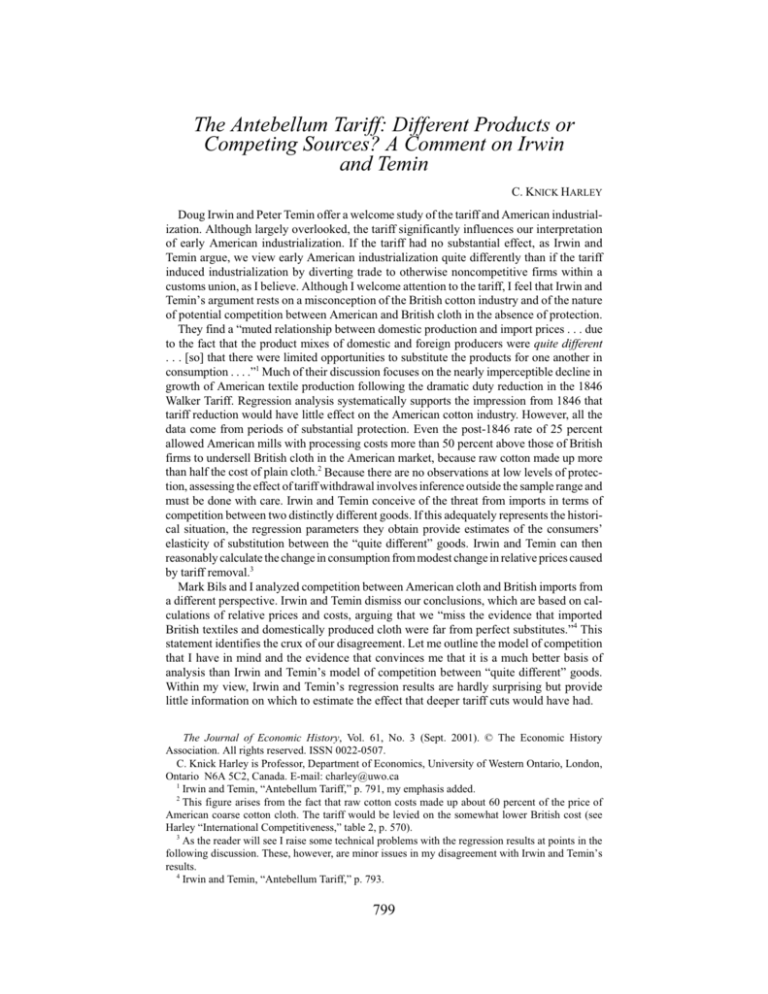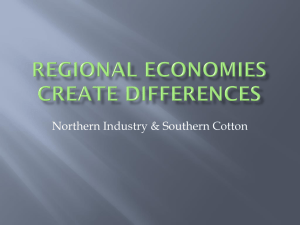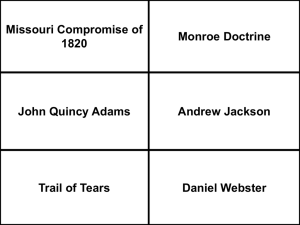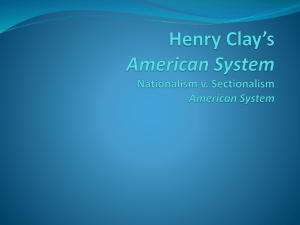
The Antebellum Tariff: Different Products or
Competing Sources? A Comment on Irwin
and Temin
C. KNICK HARLEY
Doug Irwin and Peter Temin offer a welcome study of the tariff and American industrialization. Although largely overlooked, the tariff significantly influences our interpretation
of early American industrialization. If the tariff had no substantial effect, as Irwin and
Temin argue, we view early American industrialization quite differently than if the tariff
induced industrialization by diverting trade to otherwise noncompetitive firms within a
customs union, as I believe. Although I welcome attention to the tariff, I feel that Irwin and
Temin’s argument rests on a misconception of the British cotton industry and of the nature
of potential competition between American and British cloth in the absence of protection.
They find a “muted relationship between domestic production and import prices . . . due
to the fact that the product mixes of domestic and foreign producers were quite different
. . . [so] that there were limited opportunities to substitute the products for one another in
consumption . . . .”1 Much of their discussion focuses on the nearly imperceptible decline in
growth of American textile production following the dramatic duty reduction in the 1846
Walker Tariff. Regression analysis systematically supports the impression from 1846 that
tariff reduction would have little effect on the American cotton industry. However, all the
data come from periods of substantial protection. Even the post-1846 rate of 25 percent
allowed American mills with processing costs more than 50 percent above those of British
firms to undersell British cloth in the American market, because raw cotton made up more
than half the cost of plain cloth.2 Because there are no observations at low levels of protection, assessing the effect of tariff withdrawal involves inference outside the sample range and
must be done with care. Irwin and Temin conceive of the threat from imports in terms of
competition between two distinctly different goods. If this adequately represents the historical situation, the regression parameters they obtain provide estimates of the consumers’
elasticity of substitution between the “quite different” goods. Irwin and Temin can then
reasonably calculate the change in consumption from modest change in relative prices caused
by tariff removal.3
Mark Bils and I analyzed competition between American cloth and British imports from
a different perspective. Irwin and Temin dismiss our conclusions, which are based on calculations of relative prices and costs, arguing that we “miss the evidence that imported
British textiles and domestically produced cloth were far from perfect substitutes.”4 This
statement identifies the crux of our disagreement. Let me outline the model of competition
that I have in mind and the evidence that convinces me that it is a much better basis of
analysis than Irwin and Temin’s model of competition between “quite different” goods.
Within my view, Irwin and Temin’s regression results are hardly surprising but provide
little information on which to estimate the effect that deeper tariff cuts would have had.
The Journal of Economic History, Vol. 61, No. 3 (Sept. 2001). © The Economic History
Association. All rights reserved. ISSN 0022-0507.
C. Knick Harley is Professor, Department of Economics, University of Western Ontario, London,
Ontario N6A 5C2, Canada. E-mail: charley@uwo.ca
1
Irwin and Temin, “Antebellum Tariff,” p. 791, my emphasis added.
2
This figure arises from the fact that raw cotton costs made up about 60 percent of the price of
American coarse cotton cloth. The tariff would be levied on the somewhat lower British cost (see
Harley “International Competitiveness,” table 2, p. 570).
3
As the reader will see I raise some technical problems with the regression results at points in the
following discussion. These, however, are minor issues in my disagreement with Irwin and Temin’s
results.
4
Irwin and Temin, “Antebellum Tariff,” p. 793.
799
Harley
800
TABLE 1
BRITISH COTTON CLOTH EXPORTS: QUANTITIES AND AVERAGE VALUES, VARIOUS
DESTINATIONS, 1837–1860
(5 year averages)
Export
British Price to
Export United
Price
States
1837–1841
1842–1846
1847–1851
1852–1856
1856–1860
26.3
19.9
18.0
16.9
17.1
36.9
32.6
24.4
21.7
20.9
India
Brazil
Exports to
U.S.
United
U.S. Price
U.S. Price
Price
States
Exports
/ India
Exports
/ Brazil
/ Total (000 yds.) (000 yds)
Price
(000 yds.)
Price
1.40
1.56
1.36
1.28
1.22
33
26
81
146
190
107
214
261
434
707
1.43
1.82
1.56
1.55
1.44
71
77
100
126
145
1.57
1.69
1.37
1.29
1.19
Notes: All prices are average export value in pence per yard. Export volumes are in thousands of yards.
The observation for Brazil in 1853 is missing.
Source: Sandberg, Lancashire in Decline, appendix D, pp. 252–62.
Bils and I draw on models of international trade in differentiated products. These models
rest on a “Ricardian” perception of trade in which countries differ in their levels of technology but relative advantage differs over different varieties of goods. In equilibrium, the
country with the low cost of production for a particular variety supplies all the products of
that particular type. The other country will not produce that particular variety of good but
will have an advantage in other varieties that it too will provide globally. If the differentiated goods are similar they will be classified as products of the same industry and “crosshauling” occurs.5 Nonetheless, imported and domestically produced varieties will be different. Introducing tariff protection stimulates domestic production to the exclusion of imports
of some product varieties. These now domestically produced goods will be cheaper behind
the tariff than identical imports that have paid duty; and high-cost, protected domestic
manufacturers will displace low-cost foreign goods. Imports, of course, will still consist of
different varieties than domestic production. However, because the protected industry
cannot compete in markets outside its customs union, foreigners will produce identical
goods for consumption in the rest of the world.
Irwin and Temin’s assertion that all the British industry’s products differed significantly
from the cloth made in America is central to both their analysis and their criticism of Bils
and myself. The assertion, however, reflects a misunderstanding of the British industry.
Their perception seems to rest primarily on descriptions of British goods imported into
America. But, as the Ricardian model suggests, the mix of British goods imported into
America was strongly influenced by the tariff. Certainly the British industry made “fine
goods, laces, embroidery, and the like”6 not made in America (because the tariff was not high
enough). The high American tariff confined British imports to these categories while protecting simpler goods. The tariff on simpler goods completely excluded imported goods of this
type from the American market (“redundant protection”). Irwin and Temin seem to
5
In equilibrium there may be a few goods on the margin that are both domestically produced and
imported. In much of modern literature cost advantages are seen as arising from economies of scale and
endogenous technological change in particular products. Thus, for example, America imports Volvos
and exports Ford Explorers. See Grossman and Helpman, “Technology and Trade” for an overview
of the relevant theory. Temin, “Two Views”; and Harley and Crafts, “Simulating” use a similar model
in a different context.
6
Irwin and Temin, “Antebellum Tariff,” p. 792.
Comment on Irwin and Temin
801
6,000
Number Employed
5,000
4,000
3,000
2,000
1,000
0
10- 20- 30- 40- 50- 60- 70- 80- 90- 100- 110- 120- 130- 140- 150- 160- 170- 18014 24 34 44 54 64 74 84 94
4
4
4
4
4
4
4
4
4
Average Count Spun
FIGURE 1
SPINNING EMPLOYMENT BY AVERAGE COUNT OF YARN SPUN:
LANCASHIRE/CHESHIRE REGION, 1833
Source: Great Britain, House of Commons, Factory Inquiry Comission, Supplementary Report,
pp. 119–23.
feel that the presence of imports of British textiles of any kind even in the periods of very
high tariffs in the 1830s and early 1840s precludes “redundant protection”; but because
textiles were differentiated products, imports of some varieties coexisted with “redundant
protection” for others.
Irwin and Temin’s claims that “there was virtually no overlap in the counts spun in the
two countries” and “that Britain was not exporting to other markets large quantities of lower
count goods that American producers had specialized in” are mistaken.7 Table 1 provides
information about British cotton-cloth exports generally, to the United States, and to India
and Brazil—two large markets for low-quality cloth. As the Ricardian model predicts,
exports to the United States were high-value goods—as indicated by a much higher average
value than exports generally or to India and Brazil. Contrary to Irwin and Temin’s assertion,
the British industry supplied large export markets for lower-quality cloth. By the early
nineteenth century British exports had almost completely eliminated Indian exports (the
coarse cloth against which Francis Lowell sought protection) in third markets and had
captured a large market within India itself. British firms sold large amounts of cloth in India
and, even after the American 1846 tariff reduction, the value per yard was about two-thirds
of that shipped to America. Brazil, with its large slave population, provides a second large
example.
It is difficult to get a complete quantitative picture of the product mix of the British
cotton industry in the second quarter of the nineteenth century. Differentiation is most easily
illustrated in terms of the fineness of the cotton yarn (the “count”) but certainly had other
dimensions as well—complexity of weave and finish, color, style, novelty, and so on. The best
available data on the range of products come from a survey of mills around Manchester for
the 1832 Parliamentary Factory Inquiry Commission.8 The survey indicates the
7
8
Ibid., pp. 791 and 792, respectively.
British Parliamentary Papers, 1833 XX, Supplementary Report, pp. 119–23.
802
Harley
count of yarn spun and employment for 151 mills. The mills sampled tended to be larger
and more urban than typical of the industry and consequently the survey over-sampled finespinning firms relative to coarse. Nonetheless the data illustrate the range of British production. Figure 1 summarizes the report’s information on employment in spinning classified
by count of yarn spun.9
Lancashire mills produced a wide range of counts: from 200 and a little above reported
by large mills to below ten. It is obvious that the production did not have a tightly clustered
unimodal distribution. The mean of the counts weighted by spinning employment is 70, the
median, 40, and the mode falls in the upper 30s. Contemporaries talked of three branches
of the industry, which are apparent in the figure. Yarn counts in the 40s and lower were
referred to as “coarse spinning” in Lancashire by the 1830s. These yarns were used in
“ordinary” cloth—a pair of jeans uses yarn of a count a little below 20, a man’s fine dress
shirt uses yarn of 40 to 60 count. “Fine spinning” referred to counts above 100 and was
substantially a separate industry. The output of these mills was “doubled” into thread for
sewing, hosiery, and lace. The third, intermediate group made fine cloth (muslins in British,
but not American terminology).
We have no similar survey of the American industry, but the distribution of counts of
yarn spun was certainly lower, more concentrated and more symmetric. Few yarns of counts
above 40 were produced. The mode and the median of the American distribution were both
probably in the low or mid-20s counts.
Throughout the nineteenth century American consumers purchased British cotton goods
in the fine and intermediate categories. Tariff changes affected the purchase of these goods,
which satisfied quite different wants than lower-priced goods, only in so far as consumers
chose to purchase more or fewer in response to the tariff’s effect on price. Changes in their
imports had little effect on American production. Irwin and Temin’s discussion accurately
represents this situation and to a large extent their regression results indicate the limited
competition between these goods and American coarse goods. This competition, however,
is peripheral to the effect of tariff protection on the American cotton industry. The main
issue is how much of the coarse spinning market—in which the 25 percent tariff of 1846
was still prohibitive—would British firms have captured if the United States had not maintained tariff protection?
I attempted to address this question in my 1992 article by comparing the selling prices
of two well-specified and comparable cloths in Britain and America. One was a printing
cloth woven from 30-count yarn—toward the fine end of the distribution of cloth made in
America. The other was a “domestic” made with yarn of about 20 count—about the modal
American cloth. Both cloths were representative of production in both Britain and America.
Although Irwin and Temin assert that the British did not produce this type of cloth, both the
quotations I use are prices that the Economist reported weekly to indicate trends in the
British textile market.
British prices of both the cloths were significantly below American prices but the tariff
made American cloth cheaper for American buyers. The tariff was overwhelmingly redundant for both the cloths before the 1846 revision. After 1846 the duty remained high enough
to make the American cloths cheaper than imports. Consequently, there was no incentive
for Americans to switch to British cloth and American production was only slightly affected
by the reduction in duty. However, if the tariff had been removed, British cloth would have
been significantly cheaper than the American and a dramatic switch of American purchases
from American cloth to the now cheaper, identical, imported cloth would have occurred.10
9
von Tunzelman, Steam Power, p. 183, presents a similar figure.
Harley, “International Competitiveness,” pp. 565–68.
10
Comment on Irwin and Temin
803
Of course, in the 1840s the American industry had a massive installed capital base. The
price of imported cloth would still have covered the variable costs of continuing to operate
the existing American factories. As a result, although the industry would have suffered
acute distress (and would have pleaded with almost certain success for restoration of protection) it would have continued to produce an approximately unchanged quantity of output
until the existing plant became unprofitable to operate.11 New investment and the industry’s
growth, however, would have ceased.
Bils’s and my view rests on the fact that the British produced cloth that competed directly
with American cloth but was excluded by the tariff. Eliminating the tariff would have made
high-quality textiles relatively cheaper for consumers who would have adjusted consumption, the main impact, however, would have come from buyers shifting purchases from
American-produced coarse textiles to now-cheaper identical British goods. The movement
of the average value of British exports to America after the Walker tariff shows this happening (see Table 1). In the early 1840s the average value of a yard of British cloth shipped to
America was more than 50 percent higher than the average of British exports and 80 percent
more than the average of cloth shipped to India. By the late 1850s cheaper types of cloth
were finding markets in America. The average piece of cloth shipped to America exceeded
the average British export value by less than a quarter and the average export to India by
less than 50 percent.12
Irwin and Temin’s regression results fail to provide useful information about the vulnerability of the American cotton-textile industry to British competition because their analysis
revolves around American consumers switching between two quite separate goods, coarse
American textiles and higher-quality imported textiles, as prices changed. This substitution
can reasonably be seen as occurring continuously, and estimates from data with the tariff
provide useful guidance. This type of substitution, however, is not the process that would
have threatened the American industry.
We completely agree that the British advantage was greatest in fine varieties of textiles
and that the advantage fell as quality was reduced. The New England textile industry
followed a general pattern in its competition with Britain. The Americans, like other follower textile producers, were best at coarse textiles that utilized their advantages in cheap
power and somewhat cheaper raw cotton and where their technological and labor-skill disadvantages were least. In the late nineteenth century new, low-wage, textile industries in the
American South and in Asia revealed similar comparative advantage as they first displaced
low-count production, and as they increased technical prowess gradually gained
11
These same short-run considerations also came into force after 1846 limiting the decline of output
in response to the tariff reductions (see Harley “International Competitiveness,” p. 568). Consequently,
Irwin and Temin’s regression results probably underestimate the long-run effects of the tariff reduction.
12
These price observations raise an important technical issue for Irwin and Temin’s regressions that
take the average value of British exports to America as an exogenous indication of prices in Britain.
The type of goods that could be sold successfully over the tariff influenced average value and introduces a bias towards finding little influence of import price on production into their regression results.
When the tariff was increased, in say 1842, the average value of British exports to the United States
would increase because the lowest-quality imports of the previous period could not compete over the
new tariff. The regression would observe the quantity increase in American production but attribute
it to an exaggerated increase in British price, indicating insensitivity to price. Of course, the opposite
happened after 1846 with the same econometric consequences. Production was curtailed but the
regression, by using a partially endogenous price, associated it with a larger price decrease than is
warranted. This criticism of Irwin and Temin’s conclusions, however, strikes me as distinctly second
order because, even if this problem had been avoided, their regressions could offer very little information about the crucial issue of production-cost differentials in lower-count cloth fully protected by the
tariff even after 1846.
804
Harley
market share by displacing New England and British producers, respectively, gradually in
higher-quality goods.13
Tariffs enhanced high-wage New England’s position in coarse cloth but were insufficient
to exclude high-count goods. At progressively lower tariff rates, British producers could
have supplied American markets with progressively lower-quality textiles (which the
Americans produced behind the tariff wall) at prices below the American cost of production. As tariffs fell, the substitution of imports for American cloth would have occurred as
a series of more or less discrete shifts, not as a gradual process. When the cost of an imported variety of cloth, including the tariff, fell below the cost of the American equivalent,
consumers would have shifted to the now-cheaper British good. For each variety the process would have occurred quite suddenly at the crucial tariff rate. So long as the American
good was cheaper Americans did not purchase imports. As soon as the import was cheaper,
the American good lost its market unless it could reduce its costs. The tariff rates at which
the shift would occur depended on British relative cost advantages for different textile
varieties. The magnitude of the shift depended on the American market for that particular
type of textile. Irwin and Temin’s regressions provide little or no information about how
this process might have occurred because all the historical data come from periods when
most of the types of textiles consumed in American received high-enough tariff protection
to make imports more expensive than domestically produced goods. Tariff and relative cost
variations failed to affect American production because the tariff remained high enough to
insulate the American producers of most goods that Americans consumed (the tariff was
redundant).
International price and cost comparisons, as Irwin and Temin remark, are tricky undertakings. Nonetheless, they provide much better insights into the impact of tariff protection on
the American cotton industry than Irwin and Temin’s regressions. To be sure, comparative
and not absolute advantage determines trade flows. Price and cost comparisons will miss
general-equilibrium adjustments to a changed tariff regime. Even though American costs
exceeded British prices in the 1840s, the American industry might have survived repeal of
the tariff if prices of factors employed in the industry fell in response. If, for example, New
England labor had been sufficiently immobile, tariff removal might have caused New
England wages to fall enough to support continued cotton-textile production. Although this
type of factor immobility and factor price response would be missed by price and cost
comparisons, the calculations indicate the extent of the changes required. A history of actual
tariff removal would reveal the general equilibrium effects, but regressions based on responses in periods of relatively high tariffs cannot be expected to provide much information
to their extent.
We still cannot assess the importance of the tariff to American industrialization with
complete confidence. While Irwin and Temin suggest that the tariff had little impact, their
conclusion rests on an unrealistic perception of the competition between British and American textiles. More realistic analysis suggests that the tariff had a central importance. Perhaps
the American cotton industry could have survived the removal of the tariff in the antebellum
years, but it would have done so only if the removal of the tariff resulted in a considerable
fall in wages or in the return to capital in New England.
13
See Wright, Old South, pp. 129–37.
REFERENCES
Bils, Mark, “Tariff Protection and Production in the Early U.S. Cotton Textile Industry.”
This JOURNAL 44, no. 4 (1984): 1033–45.
Comment on Irwin and Temin
805
Great Britain, House of Commons. Factory Inquiry Commission: First Report, Employment
of Children in Factories. Parliamentary Papers 1833 XX (Reprinted Irish University
Press Series of British Parliamentary Papers, Industrial Revolution: Children’s Employment 3).
Grossman, Gene M., and Elhanan Helpman. “Technology and Trade.” In Handbook of
International Economics, Vol. III, edited by Gene M. Grossman and Kenneth Rogoff,
pp. 1279–337. Amsterdam: Elsevier Science, 1995.
Harley, C. Knick. “International Competitiveness of the Antebellum American Cotton
Textile Industry.” This JOURNAL 52, no. 3 (1992): 559–84.
Harley, C. Knick, and Nicholas Crafts. “Simulating the Two View of the British Industrial
Revolution.” This JOURNAL 60, no. 3 (2000): 819–41.
Irwin, Douglas A., and Peter Temin. “The Antebellum Tariff on Cotton Textiles Revisited.”
This JOURNAL 61, no. 3 (2001): 777–98.
Sandberg, Lars G. Lancashire in Decline: A Study in Entrepreneurship, Technology, and
International Trade. Columbus: Ohio State University Press, 1974.
Temin, Peter. “Two Views of the British Industrial Revolution.” This JOURNAL 57, no. 1
(1997): 63–82.
von Tunzelman, G. N. Steam Power and British Industrialization to 1860. Oxford: Clarendon, 1978.
Wright, Gavin. Old South, New South: Revolutions in the Southern Economy since the Civil
War. New York: Basic Books, 1996.








